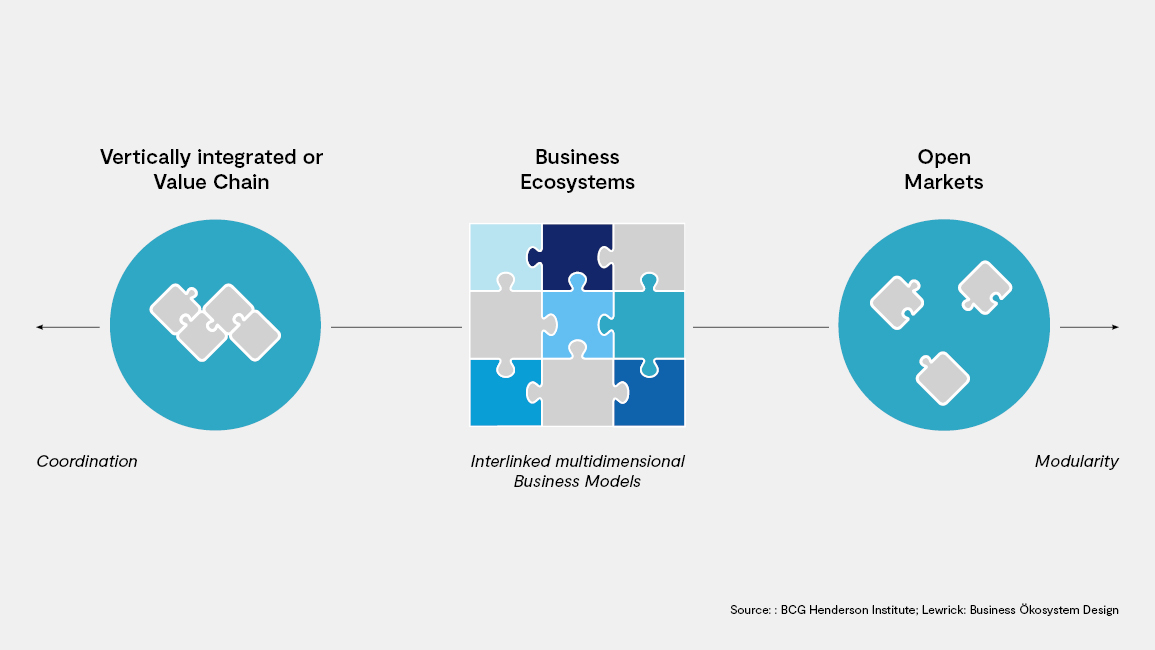Why do business models benefit from ecosystems? Recent years have seen growing popularity of the term “ecosystems” in the business world. Rightly so. But what is this buzz all about? In our two-part article “Business Ecosystems — from Buzz to Business”, we highlight the hype around business ecosystems and explain how they can enhance the value of business models. Part 1 takes an especially close look at possible drivers for entry into the world of ecosystems.
We have global players such as Amazon and Alibaba with their platforms or Google and Apple with their Play and App Stores to thank for the buzz surrounding ecosystems — and above all to the increased interest in the mechanisms and success factors behind their success. For all the differences in their markets, services, and business models, these four players have one thing in common: their success is based on well-designed, interconnected business ecosystems that bring together various service providers and developers. All of them have a common goal: to provide an attractive value proposition to their customers.
The success stories of the major players are driving entrepreneurs around the world to innovate their business models through strategic ecosystem development — with varying degrees of success. There can be no doubt that ecosystems are of vital importance for companies today. Nonetheless, it is also clear that such extensive networks cannot simply be “built” according to plan or that they will guarantee sure-fire success in the future. The establishment of an ecosystem is a long process with plenty of diversions from the straight and narrow that can lead to different results or even failure. In this respect, there is no difference to “ordinary” business models. This aspect also underscores the need for a clear view and strategy whenever ecosystems are being considered as a means of business development.
What is an ecosystem really?
Although the term “ecosystem” has become quite a popular one, the literature has evidently not yet found a consistent and, more importantly, practical definition. So what is an ecosystem, anyway?
The concept of “ecosystems” has its origins in the natural sciences, specifically in biology. Often referred to as “networks,” ecosystems generally appear in a variety of forms. One aspect is common to all of them: they represent a dense network of specific actors who are as a minimum loosely interconnected by diverse relationships and united in the pursuit of a common vision or goal. We call this common vision or goal the “focal point” that is at the heart of the ecosystem. In a business context, this may be a common target market or a jointly developed product. Every company brings its own resources and strengths to the table, empowering the network as a collective to offer a value proposition that is greater than that of the individual participants. That is why we at Detecon define business ecosystems as the sum of partnerships that serve the same customer-oriented value proposition. All participants remain independent components of a modular system with common rules and values while generating benefits for one another.
The most important aspect — and success factor — of such a business ecosystem is its value proposition. The more distinctive and customer-centric, yet simultaneously the more individualized it is, the greater the likelihood of an exceptional and unique customer experience. The ecosystem creates outstanding value for customers through its unique combination of the individual business models and capabilities of all participants and the efficient meshing of their value streams. Moreover, it maximizes the likelihood that a unique and superior value will be created for customers from the leveraging of the participants’ individual strengths, the interlinking of their business models, the efficient orchestration of resource flows, the assignment of clear roles, and the monitoring of their acceptance.

What are the key factors driving business ecosystem approaches?
Even if the key aspects of an ecosystem are known, it can still be difficult to find a good starting point for their realization. The questions that often arise are manifold. “Will an ecosystem help my business? How can I find out what impact it will have? Where do I start?”
The answers to these questions are not always simple and depend on a company’s specific situation. It must be clear that an ecosystem approach is not suitable for every company, every business idea, or every business model. Gartner’s examination of this thought distinguishes between enterprise-centric and ecosystem-centric business models. The analysts note that in many cases the “traditional” company-centric approaches may be sufficient and may even be more beneficial as some companies are in a better position to generate added value linearly by exploiting their own strengths.[1] So whether establishing a business ecosystem is truly meaningful depends on the targeted value proposition and the related demands for the skills and capabilities that are needed. The significant effort and cost are worthwhile solely if the business ecosystem has the potential of ultimately assuring superior customer value.
But how can this “superior value” be realized? We can distinguish between two main drivers for entering the world of ecosystems that lay the foundation for generating this specific value.
- EXPLORATION : This first approach is driven by the unknown, the potential opportunities for new business, and the desire to amplify the likelihood of innovation and new value propositions. Companies with an “exploratory” mindset are often visionary, willing to leave their comfort zone and to take risks that will rejuvenate their business models and products and open the door to new markets. In terms of ecosystems, this means that companies pursue an exploratory approach to the development of the final value proposition and to the utilization and establishment of ecosystem capabilities.[2]
- EXPLOITATION: This approach describes how companies endeavor to conceptualize a clearly defined value proposition on an existing market. As they strive to realize the desired value proposition, companies leverage the required partner resources that are available on an existing market to the highest possible degree through existing business ecosystems. Companies seek to take advantage of their business ecosystem to improve product quality and customer experience, increase efficiency, reduce costs, and maximize profits within that ecosystem. They are driven primarily by the desire to remain competitive and in this way to strengthen their market position.
A company may well pursue both goals/drivers at the same time (e.g., by maintaining various business units with different portfolios and market access). And yet: both drivers reflect the constant need for innovation and optimization if players are to remain competitive on dynamic markets. By tapping into the unknown and leveraging what is already available, companies can secure their viability for the future.
At the end of the day, however, it is important to emphasize that business ecosystems are complex. They demand tremendous effort — not only in their establishment, but also in their management and strategic development. Furthermore, the entirely different levels of maturity of companies are essential factors during their deliberations on the subject. Drawing on numerous discussions with clients and experts, Detecon has been able to identify at least four different starting points for approaching the issues. These entry levels reflect the most common initial positions of our clients and are described in more detail in the second part of our article series Business Ecosystems — from Buzz to Business.
[1] „Eight Ways Ecosystems Supercharge Business Models“ von Gartner
[2] See also "Business Ökosystem Design" by Michael Lewrick








